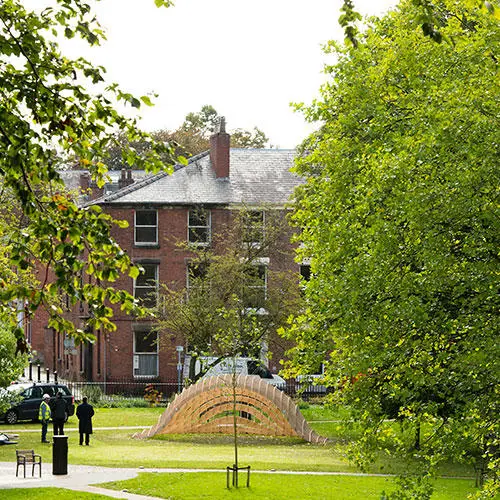Two structures were designed and created by a UCLan student, alumnus and staff for Lancashire Encounter
A team of architects and artists linked to the University of Central Lancashire (UCLan) have created two eye-catching pavilions for a county festival.
The wooden structures were designed and built to provide performance spaces in Preston’s Winckley Square for the recent Lancashire Encounter Festival.
Architecture student Rainer Townend; Charles Quick, Professor of Public Art Practice; Senior Architecture Lecturer Ann Vanner, who is President of the North Lancashire Society of Architects (NLSA - a branch of the RIBA), and UCLan alumnus John Bridge, Architect and Director of Studio John Bridge Ltd, were all involved in the project.
John, who developed the original design of the Preston Pavilion after working with the UCLan academics, said: “The Preston Pavilion is a depiction of Preston’s regeneration, from the ground grows a structure that celebrates the revolution of the 100-year anniversary of Women’s right to vote.
The new UCLan Leader in Residence* added: “This was a truly wonderful collaborative project that engaged a Lancashire team of makers and passionate people from our creative community, such as: LCM group, Sleater and Watson and UK industrial services. UCLan and NLSA have funded a project that brought a unique CAD/CAM digitally designed/fabricated structure to our city, that was enjoyed by many.”
"This was a truly wonderful collaborative project that engaged a Lancashire team of makers and passionate people from our creative community"
Both pavilions were created from plywood. The large pavilion, entitled Organic City Evolution Meets Revolution, used a lattice structure and double curves to create the open spaces. A specialist construction process was replicated by Rainer who won a design competition to create his smaller pavilion, called Shell.
The 24-year-old, from Cheshire, spent the summer on work experience with John’s architecture practice. He said: “It’s really quite amazing and overwhelming to see my winning design turned into a reality for a public event. It’s been a busy three to four weeks ensuring everything was ready, but I’m delighted with the end result.”
The high winds and heavy rain hampered the construction phase, but the team battled the elements and worked together to erect the attractive structures in time for the start of the annual creative event.
Professor Quick added: “The School of Art and Design and Fashion was very pleased to be invited to be a partner in this temporary pavilion project. It was a great example of how working together can create exciting projects for the city.
“Once removed from the public space, it is hoped the structures can find a more permanent home somewhere in the city.”


